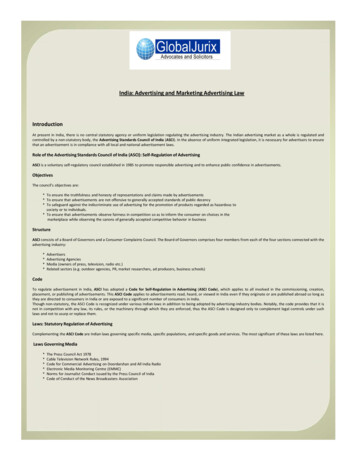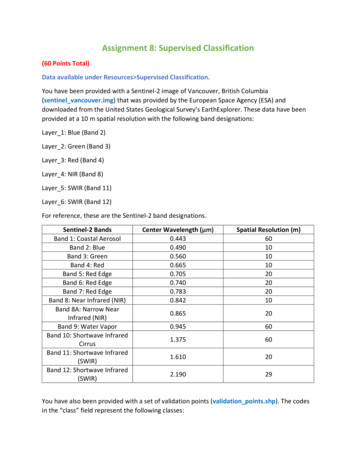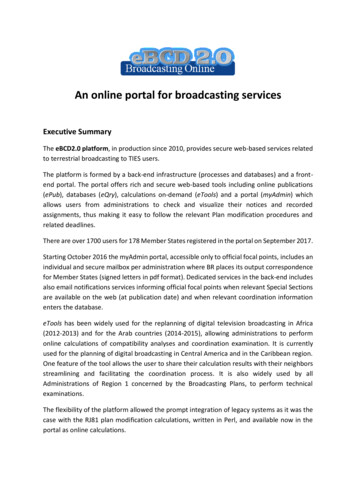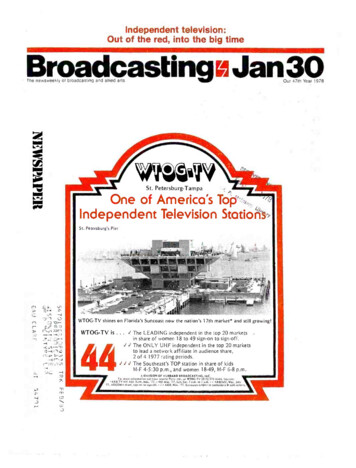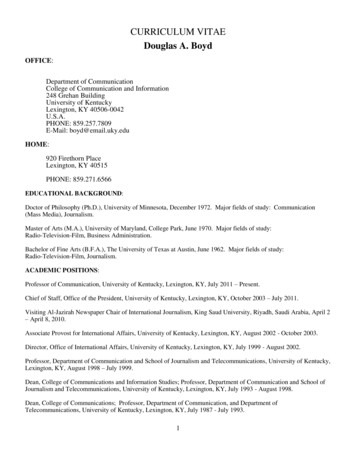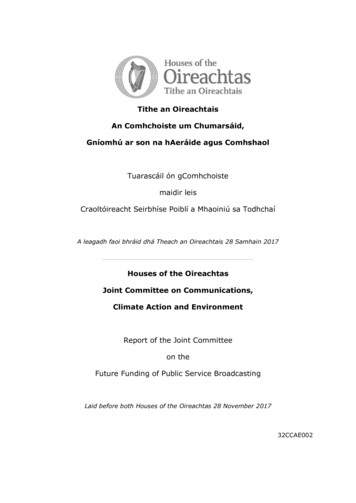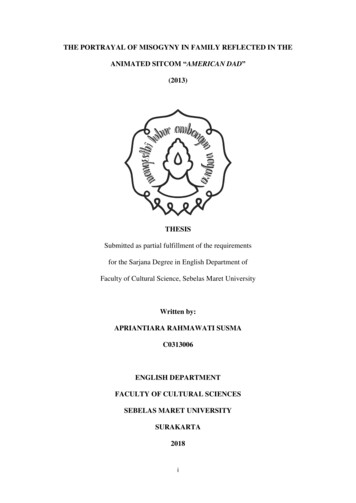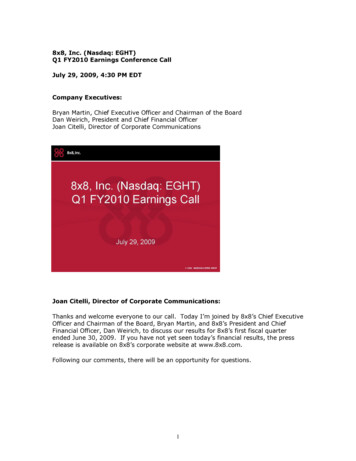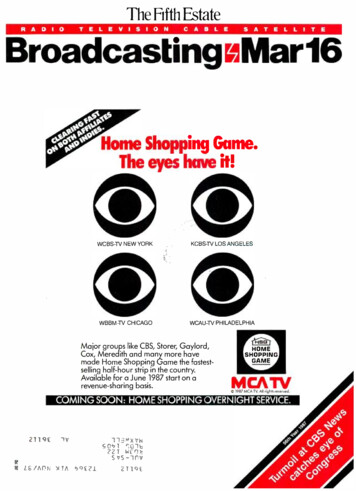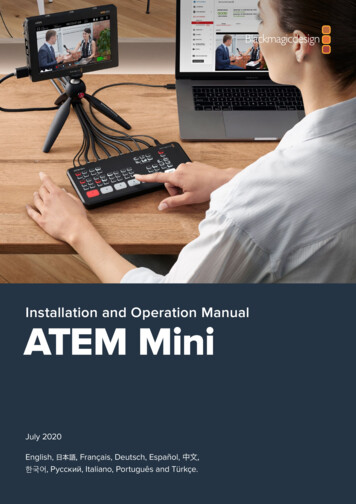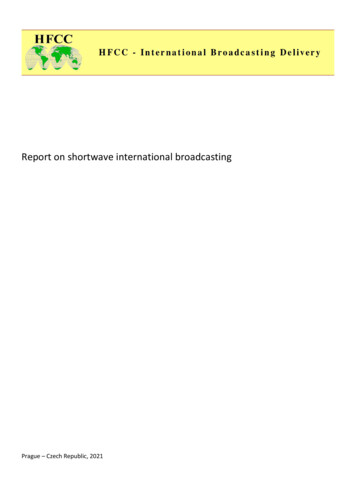
Transcription
Report on shortwave international broadcastingPrague – Czech Republic, 2021
HFCC Report on Shortwave International broadcasting 2020IndexPreamble . 3Introduction . 3Broadcasting Service . 3Rearranging the distribution strategy . 3Broadcasting Plans . 5The internet . 6Delivery platforms: pros and cons . 7Conclusion . 8Bibliography . 9Contact .9Index of graphsGraph 1, HFCC data - Hours/week: trend in the period **A10 - A20 .4Graph 2, HFCC data - Hours/week: difference between A10 and A20 . .4Graph 3, BBC - Hours/week: difference between A10 and A20 . . .5Graph 4, China Radio International - Hours/week: difference between A10 and A20 .5Graph 5, Percentage of individuals using the Internet by region and developing staus, 2019 . .6Graph 6, Percentage of population not using the Internet, 2019 . .7 HFCC 1999-2021 All Rights Reserved2
HFCC Report on Shortwave International broadcasting 2020PreambleMedia services are often available on different and diversified platforms; nevertheless, their availability could belimited for reasons independent of the will of the general audience, i.e. economic, lack of infrastructure, etc.Although in many areas these platforms exist and complement each other, they cannot fully replace shortwave, (SW),in all areas.IntroductionThis report is intended to offer information to international broadcasters about the importance of shortwavebroadcasting in the current and future panorama of international broadcasting distribution platforms.Broadcasting ServiceThe broadcasting service is defined as a radiocommunication service in which the transmissions are intended for directreception by the public. This service may include sound transmissions, television transmissions or other types oftransmission (§ 1.38 of Radio Regulations)There are several methods used for broadcasting electronic media - audio and video - to the general public: Radio broadcasting: audio signals sent through the air as radio waves from a transmitter, picked up by anantenna and sent to a receiver; Television broadcasting: an extension of radio to include video signals; Cable radio and cable television: both via coaxial cable, originally serving principally as transmission media forprogramming produced at either radio or television stations, but later expanding into a broad universe ofcable-originated channels. Direct-broadcast satellite (DBS) and satellite radio: meant for direct-to-home reception; Webcasting of video/television and audio/radio streams: radio and television programming with dedicatedInternet radio and Internet television.International broadcasting is broadcasting that is deliberately aimed at a foreign, rather than a domestic, audience.An international broadcaster has several options for reaching a foreign audience: by means of radio broadcasting, e.g.longwave, mediumwave, or (more usually) shortwave radio and in more recent years also the use of direct satellitebroadcasting and the internet.Rearranging the distribution strategyThe content distribution strategy adopted by most of the international broadcasters includes all the above methodsand, at the same time, is tailored to how the foreign audience can best access the different distribution platforms.The rise of broadband, evolving consumer behaviour plus the economic recession, have made some internationalbroadcasters reconsider and rearrange their distribution strategy: for instance, some international broadcasters haveabandoned shortwave broadcasting altogether, relying on internet and satellite transmissions only, because itsaudience can easily access them without any constraint, either technical or economical or for other reasons (see graph1 and 2); others have abandoned or reduced shortwave transmissions to specific areas only (see graph 3), relying onlocal relays, the Internet, and satellite transmissions; others have maintained the same amount of shortwavebroadcast hours per week or even increased SW hours, overall or to a specific area (see graph 4).3
HFCC Report on Shortwave International broadcasting 2020*HFCC data - Hours/week: trend in the period **A10 - A14B13A13B12A100SeasonGraph 1 (HFCC - International Broadcasting Delivery)iGraph 2 - The decrease in the number of SW broadcast hours has not equally affected the macro service areas: forinstance, the services beamed to Europe have been decreased by 52.9 % whereas the services to Asia have beendecreased by 27.4 %. (HFCC - International Broadcasting Delivery)ii* The HFCC is a non-governmental, non-profit association, and a sector member of the International Telecommunication Union inGeneva in the category of international and regional organisations. It manages, and co-ordinates global databases of internationalshortwave broadcasting in keeping with International Radio Regulations of the ITU. More information at www.hfcc.org .** The use of the frequency bands allocated to high frequency broadcasting (HFBC) between 5 900 kHz and 26 100 kHz is basedon the principles given in Article 12 of the ITU Radio Regulations in conformity with seasonal planning based on a coordinationprocedure between administrations or authorized broadcasters; twice yearly, administrations shall submit their projectedseasonal broadcasting schedules in the relevant frequency bands to the Bureau. These schedules shall cover the seasonal periodsA, last Sunday in March to last Sunday in October, and B, last Sunday in October to last Sunday in March.4
HFCC Report on Shortwave International broadcasting 2020Graph 3 – The BBC is one of the international broadcasters who, in the period A10-A20, has reduced shortwavetransmissions to specific areas, moving programming onto local FM relays, DTH satellite and Online via mobile 3G/4Gor the Internet. (HFCC - International Broadcasting Delivery)iiiGraph 4 – In the period A10-A20 CRI has maintained the same amount of shortwave broadcast hours per week tosome service areas and has even increased SW hours to other areas. (HFCC - International Broadcasting Delivery)ivBroadcasting PlansThe choice of a distribution platform is determined by its capacity to reach the audience thanks to its technicalcharacteristics. However, use of the electromagnetic spectrum is governed with respect to the relevant provisions5
HFCC Report on Shortwave International broadcasting 2020provided by the International Telecommunication Union Radio Regulations, ITU-RR: the broadcasting service in theLong and Medium Wave range is subject to regional frequency assignment plans, Geneva 1975 for Region 1 and 3 andRio de Janeiro 1981 and 1988 for region 2; the use of the FM band for sound broadcasting services in Region 1 andpart of Region 3 is governed by the Geneva 1984 Plan; the broadcast-satellite service is governed by Appendix 30 and30A; SW broadcasting is based on a coordination procedure described by Article 12 of the ITU-RR; etc.The above-mentioned broadcasting Plans are intended for national coverage and any change to the Plan has to getthe agreement of the affected Administrations, identified by the relevant provisions in the Plan itself, before itsimplementation. Likewise, the coverage of a territory by a fixed-satellite service in the frequency bands governed byAppendix 30 is subject to the authorization of the administration whose territory is covered by the satellite in question.In addition, the use of a frequency in any country is regulated by local legislation, e.g. an administration could ban thebroadcast of content in its territory by foreign broadcasters.In the international broadcasting scenario, SW is the only platform not subject to the agreement of the administrationwhose territory is covered by the SW signal: this regulatory framework and its propagation characteristics makes SWthe only medium able to be used internationally, to serve the general public in foreign countries, regulated by thecountry in which the broadcaster is based.The InternetUse of the internet continues to grow: according to the ITU Publication ”Measuring digital development - Facts andFigure 2019”, 4.1 billion people were using the Internet in 2019 reflecting over 53% of the world's population. Indeveloped countries, most people (87%) are online; on the other hand, only 19% of individuals are online in the leastdeveloped countries, LDCs (see Graph 5).Graph 5 (ITU Telecommunication Development Sector)vThe map of the offline population highlights regional differences in Internet usage. Countries with the highestproportion of people not using the internet are mostly in Africa and South Asia, although there are inter-regional6
HFCC Report on Shortwave International broadcasting 2020differences. It should be also considered that broadband is still expensive in LDCs; although considerable progress hasbeen made, affordability remains a challenge in many countries. (See Graph 6).Graph 6 (ITU Telecommunication Development Sector)viDelivery platforms: pros and consAs already anticipated at the beginning of this document, some international broadcasters replaced shortwave byother content delivery platforms, i.e. the Internet, the local FM relay network and satellite, but every technology hasits drawbacks: Internetthe Internet is becoming more and more available but 47% of the world’s population does not have access toit, 80 % in the LDCs;the Internet can be easily censored or controlled and access to it can be limited or unavailable due toinfrastructure problems;the Internet cannot preserve the anonymity of the user;Internet access may be only available at Internet cafes or libraries;the Internet may be available, but speeds may not be sufficient to listen to audio streams from broadcasters. FMMostly for local coverage. In general, FM does not reach vast rural areas;The use of local stations may be limited because of changes in laws and political situations. SatelliteSatellite broadcasting is mainly for TV. A very small percentage of its audience ever listens to radio via satellite;Reception is by non-portable and expensive equipment. 7
HFCC Report on Shortwave International broadcasting 2020 Shortwave (also Mediumwave for some countries)Reception is difficult in urban areas because of excessive noise;Reception can be affected by interference from other stations;Shortwave transmitting stations are expensive to operate.The weak points of the Internet, FM and satellite are the strong points of shortwave: Broadcasts reach listeners over large areas far away from the transmitting site; It is free to air; The listener cannot be identified; There isn’t any need for previous agreement from the Administration of the territory where the broadcast isbeing aimed at; The receiver can be portable and inexpensive;Since shortwave broadcasts propagate over very long distances, they are subject to interference from other SWstations around the world; to remedy the situation it is necessary that HF broadcasting services are coordinatedpursuant to the procedure described by Article 12 of the RR.Radio broadcasting can be considered the most resilient and most widely available platform to reach out to people: Shortwave radio is an invaluable tool in distance education, a convenient option for students who are unableto take traditional classes. It can be used to promote literacy amongst youth and adults alike where traditionaleducation systems cannot due to lack of financial means, education infrastructure or accessibility. By usingdigital technology, e.g. Digital Radio Mondiale (DRM), shortwave can deliver radio programmes as well as bothaudio and visual content to millions of students who have no access to IP connections and related devices; Shortwave, among other radio services, can also be used to provide health education and information tocommunities during epidemics; Shortwave radio often remains the only source of information for areas affected by disasters, man-made ornatural, when local and regional communication networks can be overloaded or destroyed, resulting in aninformation blackout. Furthermore, DRM's Emergency Warning Functionality (EWF) can disseminate disasterwarnings to radio listeners, and can add a whole set of modern features to any modern national alert network.ConclusionInternational broadcasters should be committed to ensure that content is reaching audiences on theappropriate media.Broadcasters need to continue on shortwave because: From a technical point of view, there is nothing to replace shortwave currently;Shortwave radio often remains the only source of information for areas affected by disasters, man-madeor natural, when local and regional communication networks can be overloaded or destroyed, resulting inan information blackout. Furthermore, DRM's Emergency Warning Functionality (EWF) can disseminatedisaster warnings to radio listeners, and can add a whole set of modern features to any modern nationalalert network.they need to deliver content to regions where a critical need for the platform continues;they need to broadcast appropriate international media and reach difficult and wide areas without anInternet connection (about 47% of the world's population);It is free to air;The listener cannot be identified;There isn't any need for previous agreement from the Administration of the territory where the broadcastis being aimed at.8
HFCC Report on Shortwave International broadcasting 2020 DRM can be used to deliver studio quality programme for relaying by local radio stations.Shortwave radio can be deployed as a distribution medium for FM radio and cellular ments/facts/FactsFigures2019.pdfiiContactHFCC – International Broadcasting DeliveryVinohradska 28 – dvurCZ-120 00Praha 2Czech RepublicTel: 420 737346541, 1 305 5599764http://www.hfcc.org9
HFCC Report on Shortwave International broadcasting 2020 5 Graph 3 - The BBC is one of the international broadcasters who, in the period A10-A20, has reduced shortwave transmissions to specific areas, moving programming onto local FM relays, DTH satellite and Online via mobile 3G/4G or the Internet. (HFCC - International Broadcasting Delivery)iii
